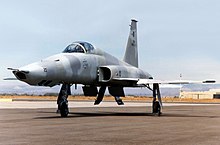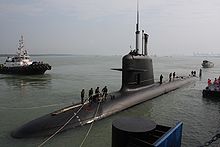Armed Forces of Malaysia
|
|||

|
|||
| guide | |||
|---|---|---|---|
| Commander in Chief : | Malaysian monarch currently Mizan Zainal Abidin | ||
| Defense Minister: | Ahmad Zahid Hamidi | ||
| Military Commander: | General Abdul Aziz Zainal | ||
| Military leadership: | Armed Forces Council | ||
| Military strength | |||
| Active soldiers: | 106,000 | ||
| Conscription: | |||
| Eligibility for military service: | |||
| Share of soldiers in the total population: | 0.38% | ||
| Share of gross domestic product : | 1.01% (2017) | ||
| history | |||
| Founding: | 1963 | ||
| Factual foundation: | 1952 (Federation of Malaya) | ||
The Angkatan Tentera Malaysia (ATM) are the armed forces of Malaysia and are divided into land forces ( Army ), Marine and Air Force . They were founded in 1963 at the same time as the state of Malaysia. The nominal commander in chief is the Yang di-Pertuan Agong , the King of Malaysia, currently Abdul Halim Mu'adzam Shah . The military leadership is the responsibility of the Panglima Angkatan Tentera (Chief of Defense Force), currently General Abdul Aziz Zainal.
history
The Malaysian Armed Forces can trace their history back to earlier military units that arose under British colonial rule. The British concentrated their soldiers, whose men usually came from India, in Singapore . In the sultanates only armed police units made up of Indians were set up, such as the 1st Perak Sikhs (1874), Selangor Military Force (1875, 530 men) and Sungei Ujung Police (1874). In the 1895 treaty, the princes undertook to collectively finance the Malay States Guides , which were formed from the police forces . There was also the 1st Battalion Perak Sikhs. All of these mercenaries were recruited in Punjab and commanded by the British. A European militia, the Malay States Volunteer Rifles , was set up in 1902 (1911: 561 men, 22 officers, 6 months of training). The First Malay Experimental Company was established on March 1, 1933 and consisted of Malay recruits and British instructors. In 1935 it was upgraded to the Malay Regiment , a short time later, for the first time, Malays were used as officers instead of just as simple men as before. When Japan conquered large parts of Southeast Asia during World War II , the Malay Regiment, which had now grown to 1,400 soldiers, joined forces with British units in the ultimately unsuccessful defense of the Malay Peninsula and Singapore. It was disbanded during the Japanese occupation. The Malay Regiment, which had already been re-established in September 1945 with the surviving veterans of the pre-war unit, was constantly strengthened and by 1953 had reached a strength of seven battalions or around 5000 soldiers. In 1952 the Federation Regiment and the Federation Armored Car Squadron were also founded. The Malaya Federation (at that time still a British colony) now had its own de jure army for the first time. On August 31, 1957, the Malaya Federation, consisting of the nine Malay sultanates and the two Straits Settlements Penang and Malacca , gained their independence. The Malayan Emergency , the fight with the Malayan Races Liberation Army (MRLA) lasted until 1960. On September 16, 1963, a new federation was founded under the name Malaysia , which also included the British Crown Colony of Singapore and the protectorates of North Borneo (now Sabah ) and Sarawak included. Today's armed forces were formally re-established from the units of the Malaya Federation and the Sarawak Rangers . The early years were determined by territorial claims of the neighbors, in particular the Konfrontasi (1963-1966) initiated by Indonesia, the departure of Singapore from the federation in 1965 and the North Borneo dispute , in which the Philippines claimed Sabah ( the former North Borneo ) want to assert. The armed forces of Malaysia were supported by Australia and Great Britain until 1971 under the ANZAM and the Anglo-Malayan Defense Agreement . From the 1990s, the Malaysian armed forces have been extensively modernized. Malaysia also participated in global peace missions . Malaysia spent just under 1.1 percent of its economic output or 3.5 billion dollars on its armed forces in 2017 with a total strength of just over 100,000 active soldiers.
organization
army
The Malaysian Army ( malay. Tentera Darat Malaysia ) is the largest of the three armed forces with 86,000 men. It consists of four divisions , each of which is responsible for part of the Malaysian national territory. Three of these divisions are stationed on the Malay Peninsula and the fourth on the island of Borneo .
| designation | Area of responsibility (affected states ) | Neighbor states |
|---|---|---|
| 1st division (1 division) | East Malaysia ( Sarawak & Sabah ) | Indonesia , Brunei |
| 2nd division (2 divisions) | Northern Peninsula ( Kedah , Kelantan , Penang , Perak (north), Perlis , Terengganu ) | Thailand |
| 3rd division (3 divisions) | Southern Peninsula ( Johor , Malacca , Negeri Sembilan , Pahang (east)) | Singapore |
| 4th division (4 divisions) | Central Peninsula (federal territories Kuala Lumpur and Putrajaya , Selangor , Pahang (west), Perak (north)) | / |
The individual divisions are each divided into several brigades and also have independent units. With a paratrooper brigade and additional artillery and tank units as well as the special unit Grup Gerak Khas (GGK), the army command itself has independent units that are not subordinate to the divisions.
The strength and equipment of the individual divisions differ depending on the area of responsibility, so the 3rd Division, located in the south of the Malay Peninsula and thus close to Singapore, has three brigades with a total of nine active infantry battalions (three of them as mechanized infantry ), two armored and five Artillery battalions, while the 4th Division, which is mainly responsible for protecting the capital Kuala Lumpur, has only two brigades with a total of four active infantry battalions and no tank or artillery units.
marine
The Malaysian Navy ( Tentera Laut Diraja Malaysia ) has a staff of 12,000 men. It operates from several ports and an air base. The area of responsibility of the navy is divided into three areas, each of which is monitored by a command command ( MAWILLA - Markas Wilayah Laut ). The naval air base is located in Lumut in the state of Perak. The Navy also has a combat swimmer unit, the Pasukan Khas Laut (PASKAL).
| designation | Area of responsibility | headquarters |
|---|---|---|
| MAWILLA 1 | Southern Strait of Malacca , southern part of the South China Sea | Kuantan |
| MAWILLA 2 | Northern part of the South China Sea | Kota Kinabalu |
| MAWILLA 3 | Northern Strait of Malacca, Andaman Sea | Langkawi |
Air Force
With a staff of 8,000, the Air Force ( Tentera Udara Diraja Malaysia ) is the smallest military force in Malaysia. They are divided into two divisions, with the 1st division being responsible for western and the 2nd division for eastern Malaysia. There are several air bases across the country, and the Pasukan Khas Udara (PASKAU) special forces unit is part of the air force.
equipment
As the army of a non-aligned state , the Malaysian armed forces procure their equipment from both Russian and Western spheres of influence. The Malaysian Air Force, for example, owns both American F / A-18D Hornet fighter aircraft and their Russian competitor Su-30MKM .
The army has made in recent years several modern large purchases, including the from Poland coming battle tanks PT-91M and the Brazilian multiple rocket launchers - artillery system Astros II .
The soldiers' orderly weapon is the Austrian Steyr AUG A1 , which is to be replaced by the American M4A1 over the next few years .
The Navy is currently procuring six Kedah- class warships , which are also called New Generation Patrol Vessels in Malaysia and belong to the MEKO 100 series of ships from the German shipyard Blohm + Voss . In addition, two were submarines of the Scorpene class ordered, the first of which, the Tunku Abdul Rahman , in September 2009 at the naval base in Port Klang arrived.
Web links
- Malaysian Armed Forces homepage (Malaysian)
- Unofficial site about the Malaysian Armed Forces (English)
Individual evidence
- ^ The World Factbook
- ↑ Patrick Morrah: The History of the Malayan Police , Journal of the Malayan Branch, Royal Asiatic Society, Vol. XXXVI (1963), Pt. 2, No. 202, pp. 46-79
- ↑ see also: SMS Emden (1908) (mutiny of the guards 1915 in Singapore)
- ↑ Lim Kai Tong (1999): The Malay Regiment - "Ta'at Dan Setia": 1933-1945 .
- ↑ Kevin Blackburn: The commemoration and memory of the Malay Regiment in modern Malaysia and Singapore . In: Karl Hack / Tobias Rettig (eds.): Colonial armies in Southeast Asia , Routledge: Oxon, New York 2006, ISBN 0-415-33413-6 , pp. 302–326.
- ↑ United Nations Treaty Registered No. 8029, Manila Accord between Philippines, Federation of Malaya and Indonesia (July 31, 1963) ( Memento of January 11, 2012 in the Internet Archive )
- ↑ UNTS No. 8809, Agreement relating to the implementation of the Manila Accord in: United Nations Treaty Series (PDF file; 5.56 MB)
- ↑ PROCLAMATION OF SINGAPORE
- ↑ Home | SIPRI. Retrieved July 10, 2017 (English).
- ↑ Bernama (April 27, 2006): Malaysia Replaces Steyr Assault Rifle With Colt M4 Carbine .
- ↑ www.themalaysianinsider.com - First Scorpene submarine arrives in Port Klang ( Memento of the original from September 5, 2009 in the Internet Archive ) Info: The archive link was automatically inserted and not yet checked. Please check the original and archive link according to the instructions and then remove this notice. , September 3, 2009. (English)



